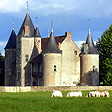CAVES
OF AZÉ AND BLANOT
Cave Exploring and Pre-Historic Man in Burgundy
 Wandering
through the wine region of Southern Burgundy mind your feet or you’re
liable to fall into a big hole. Like ancesters long past you're tredding
400,000 years of footsteps of prehistoric man before you. Some of the
best pre-historic caves in France are in the area of the low hills
between the Saône and Loire Rivers, where long after the cavemen
stopped living in the rock, now only cooling wine dwells in caves.
While driving the back roads of wine vineyards between Tournus and
Cluny, follow the signs to Azé.
Wandering
through the wine region of Southern Burgundy mind your feet or you’re
liable to fall into a big hole. Like ancesters long past you're tredding
400,000 years of footsteps of prehistoric man before you. Some of the
best pre-historic caves in France are in the area of the low hills
between the Saône and Loire Rivers, where long after the cavemen
stopped living in the rock, now only cooling wine dwells in caves.
While driving the back roads of wine vineyards between Tournus and
Cluny, follow the signs to Azé.
Azé Caves
 Unremarkable
from the surface with a snack shop and a small natural spring fountain,
the clue of what lies beneath can be determined perhaps by the school
bus of children on a day outing. The caves of Azé (Grottes Azé)
is an amazing network of caverns with its own flowing underground river
coursing along the railed pathway on the lower level. Cavemen lived
in societies here for thousands of years and the caves provide some
recreated exhibits of what life might have
Unremarkable
from the surface with a snack shop and a small natural spring fountain,
the clue of what lies beneath can be determined perhaps by the school
bus of children on a day outing. The caves of Azé (Grottes Azé)
is an amazing network of caverns with its own flowing underground river
coursing along the railed pathway on the lower level. Cavemen lived
in societies here for thousands of years and the caves provide some
recreated exhibits of what life might have been
like for the ordinary Cro-Magnon family along with exhibits of the
caves discovery. Prehistoric saber toothed cave lions and bears lived
here, too, probably snacking on the human treats from time to time
and a remarkable collection of skeletons can still be seen in the archeological
museum above ground. A tour of the caves takes about an hour 30 minutes
and the snack area can be a pleasant stop to get over your wine hangover.
There is a camping ground on the premises as well for the nature inclined.
been
like for the ordinary Cro-Magnon family along with exhibits of the
caves discovery. Prehistoric saber toothed cave lions and bears lived
here, too, probably snacking on the human treats from time to time
and a remarkable collection of skeletons can still be seen in the archeological
museum above ground. A tour of the caves takes about an hour 30 minutes
and the snack area can be a pleasant stop to get over your wine hangover.
There is a camping ground on the premises as well for the nature inclined.
Solutrean Man and Blanot Grottos
Just near the small town of Blanot at the base of Mount Saint-Roman underneath the priory house of the Romanesque church, the underground maze of caves of the Grottes Blanot are marked by a monument. Below ground a maze of cave rooms on a number of levels descend to depths up to 80 meters.
In 1866 two residents of nearby Mâcon happened on a discovery of animal bones hunted by pre-historic man at the base of a unique rock formation called the Roche de Solutré. The major archeological find became the Solutré site and the Solutrean Man who was responsible for inventing the crewel needle, joined the story of the Cro-Magnon period. The Solutré Department Prehistory Museum provides a fascinating look into this period of around 25,000 years ago with exhibits of artifacts, models and audio-visual media. © Bargain Travel Europe
Compare the best travel deals in Burgundy at TripAdvisor
Where to stay see Tournus or Chateau Fleurville
Web
Info
Southern
Burgundy
These articles are copyrighted and the sole property of Bargain Travel Europe and WLPV, LLC. and may not be copied or reprinted without permission
See Also:
FAMILY
ADVENTURE TOURS IN FRENCH ALPS
ABBEY
CLUNY MONASTERY RUINS
MARBLE ARCH CAVES GEOPARK - NORTHERN IRELAND
LA BREA TAR PITS & PAGE MUSEUM - US


